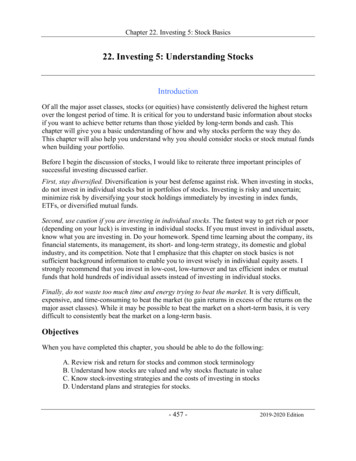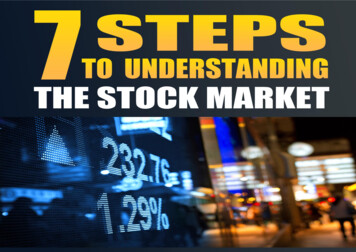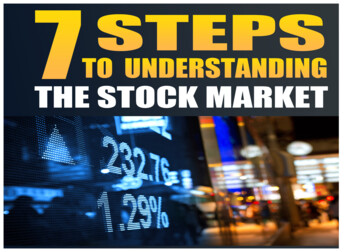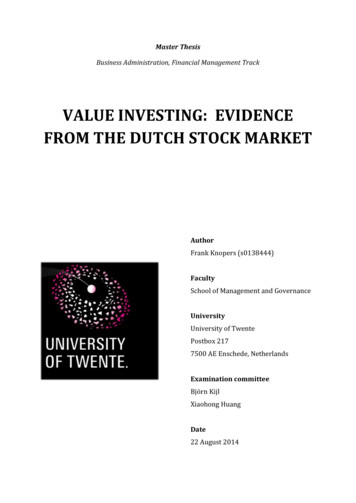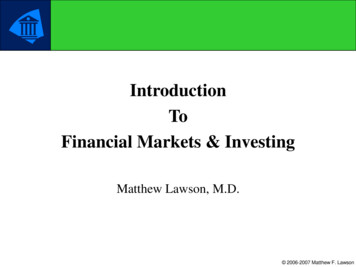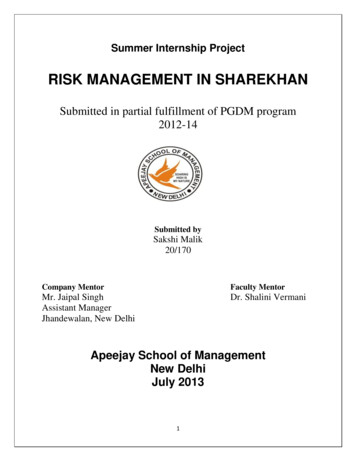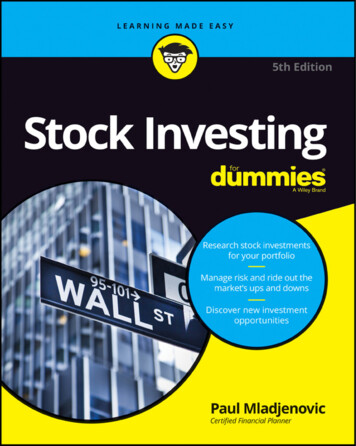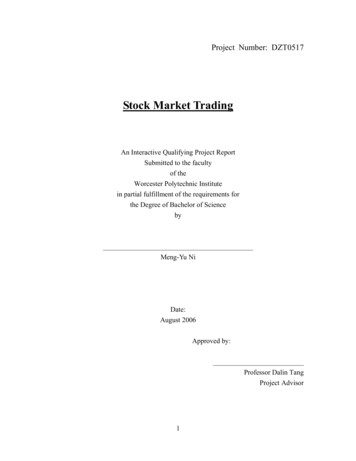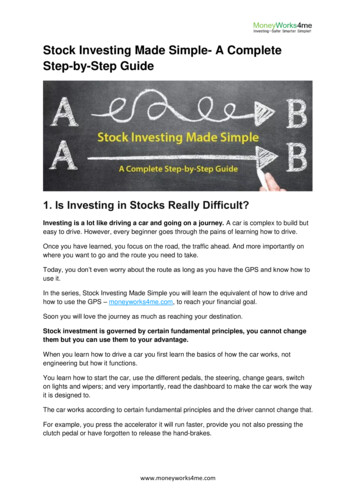
Transcription
Stock Investing Made Simple- A CompleteStep-by-Step Guide1. Is Investing in Stocks Really Difficult?Investing is a lot like driving a car and going on a journey. A car is complex to build buteasy to drive. However, every beginner goes through the pains of learning how to drive.Once you have learned, you focus on the road, the traffic ahead. And more importantly onwhere you want to go and the route you need to take.Today, you don‘t even worry about the route as long as you have the GPS and know how touse it.In the series, Stock Investing Made Simple you will learn the equivalent of how to drive andhow to use the GPS – moneyworks4me.com, to reach your financial goal.Soon you will love the journey as much as reaching your destination.Stock investment is governed by certain fundamental principles, you cannot changethem but you can use them to your advantage.When you learn how to drive a car you first learn the basics of how the car works, notengineering but how it functions.You learn how to start the car, use the different pedals, the steering, change gears, switchon lights and wipers; and very importantly, read the dashboard to make the car work the wayit is designed to.The car works according to certain fundamental principles and the driver cannot change that.For example, you press the accelerator it will run faster, provide you not also pressing theclutch pedal or have forgotten to release the hand-brakes.www.moneyworks4me.com
In which case pressing the accelerator and giving more fuel will only rev the engine, make alot of noise and spoil your car.And losing your cool and cursing the car will do the same to your body and also hurt yourpassengers‘ peace of mind. A good driver knows these fundamentals.What is the right price to buy a stock?To answer this you need to know the most important principle of Stock investing: Thefair value of a stock depends on its ability to generate profits consistently, and that themarket prices in the long term always depend on this.Therefore it is sensible to anchor the buying price to a stock‘s fair value. You may buy at adiscount to its fair price to be on the safer side or close to the fair price.However, this is not a simple straight-line affair because of what happens every day in thestock market.Why do stock prices change every day?Short term stock prices are driven by demand and supply. Daily and short term pricemovement depends on the number of buyers versus a number of sellers.Many, if not the most of them are traders, speculators and very few are real investors.Their reasons to buy or sell are completely different from those of investors. However, theyare in large numbers and trade-in volumes substantially larger than investors.All of them are strongly influenced by short term events and hence prices fluctuate a lot.A long term investor need not even try to make sense of these fluctuations. However, theyneed to know the fair price or value of the stock to take investment decisions.www.moneyworks4me.com
Why learn how to invest in stocks when we have options likeMutual funds?There are about 350 equity mutual funds while there are about 200 good quality stocksworth investing in. So it‘s not easy to know which mutual fund to buy.Currently, decisions are taken on the basis of past returns. But that is grossly inadequate.Stocks are the underlying assets in equity mutual funds.A fund manager decides which stocks to buy, how much and at what price.Knowing the basics of stock investing helps you better understand what the equity mutualfund is invested in and why it makes sense to buy or not buy it.And finally, you pay for these services and quite a lot, so you need to know whether you aregetting your money‘s worth.You cannot be ignorant and leave investing to your MF Distributor, Wealth Manager,Relationship Manager, your Insurance Advisor or your Broker.Because simply put-―In investing, ignorance is not bliss, Ye paise ka mamla hai.‖But isn‘t stock investing risky?www.moneyworks4me.com
Till we learn to drive a vehicle we all find it very risky. When learning how to drive a vehicle,we experience some tension and anxiety.But we don‘t abandon learning how to drive because we understand it is a necessary skilltoday.Driving always carries some risk, but we have learned how to manage it and avoidunnecessary risks.Yes, there are buses, trains, and flights, but our personal mobility needs are best served byknowing how to drive some vehicles.Investing is something you will need to do for decades and knowing the basics ofinvesting especially in stocks is a piece of necessary, life-enhancing knowledge and skill.2. What is essential for success in Stocks Investing?What would success in stock investing mean?We want our savings, our surplus money to grow to meet our financial needs and goals ofthe future.How does your surplus money grow? Does it follow a formula?Yes, actually it does; it‘s the Wealth Formula,Wealth Surplus (1 returns) years investedEssentially, when you put your surplus money to earn returns higher than inflation and let itcompound for a number of years, your savings grow into wealth.As you can see there are 3 variables, Surplus (the saving you put to work), Returns (CAGR)that you earn and No. of years you stay invested and earn these returns.What should you focus on to grow your money?www.moneyworks4me.com
The Sensible investor focuses on maximizing the 3rd variable of the Wealth Formula i.e.years invested – allowing his money to compound as long as possible.To do this he has the expectation of a sensible return i.e. substantially higher than inflationrates but not so high that it requires taking high risks.These are the kind of risks that make him so uncomfortable that he wants to exit the marketwhen it is volatile. Since he takes moderate risks he confidently invests a large portion of histotal surplus in this manner.So focusing on staying invested helps to grow money faster without running the high risk.What leads to exiting one‘s investments?The main reason investors exit their equity investments is their discomfort in handling a fallin the portfolio when the market corrects.The way to reduce the drop is ensuring asset allocation to debt and equity.For example, a 50:50 split ensures that the investor‘s portfolio drops by roughly half theamount the market corrects.So even if the market corrects by 20%, the investor sees about a 10% drop in his portfoliosomething that makes us uncomfortable but not panics.www.moneyworks4me.com
So you should not put your entire investable surplus in stocks but limit it to the extentrecommended by your risk profile.Typically this means a debt to equity as 60-40 for conservative, 50-50 for Moderate and 4060 for Aggressive profiles.What can help an investor to stay invested in his portfolio?Investing in strong companies will give you the confidence to stay invested even when themarket corrects. Imagine your portfolio is 1 cr, a 20% drop would mean a paper loss of 20lacs.A portfolio with a large amount of small and mid-cap stocks and some risky companies couldfall by this much.Would you have the heart to hold onto such companies? Most would sell and get out andincur a real loss.How long will it take to create wealth from investing?Investing is not a get rich quick formula.www.moneyworks4me.com
As you can see from the Wealth Building Formula if you wanted to get rich quick i.e. theperiod you stay invested is small, then to create wealth you need to earn very high returns;the kind of returns that are offered in casinos and race tracks, provided you win.But that seldom ever happens because the odds are always in favor of the house, thebookie, the casino. The same happens when you invest in stocks hoping to earn very highreturns.Remember investing is a marathon, not a 100-meter sprint.Now you need to choose between get-rich-quick and get- rich-definitely and sensibleInvestors choose the latter.After all, having worked hard for their money it is not sensible to let our impatience preventus from growing our savings into wealth.So what is essential to investing in stocks and succeeding?It‘s following these 2 Rules;Rule No 1: Stay invested and let the power of compounding do its magic.Rule No 2: Do things that help you follow Rule No 1; avoid the rest.These include;1. Do not invest your entire surplus in stocks. Limit it to the assetallocation recommended by your risk profile. Think max 60%.2. Keep your returns expectations from stocks reasonable say twice the returnsfrom an FD.3. Invest in strong companies only.Remember: Investing and compounding at higher than inflation rates substantially reducesthe money you need to set aside for your future goals. And all this without losing sleep.www.moneyworks4me.com
3. How to invest in a stock successfully?How to select the stocks for my portfolio?To select the stocks and build a strong portfolio you need to know:1. Which are the right stocks to invest in?2. What is the right price to invest in?3. How much of each stock should you own?Here are the answers to these 3 questions:1. Invest in stocks of great businesses.2. Invest at attractively low prices-the right price where you can earn healthy inflationbeating returns.3. Manage a diversified portfolio of around 20 such stocks.Once you accept these as the principles that guide your stock-investing decisions, you willmake fewer mistakes and none of them will derail you.More importantly, you will not get distracted and will invest your time very productively.Building a ‗Wealth Creating Portfolio‘www.moneyworks4me.com
Which is the right stock to invest in?Buying stock and investing in stock are very different things. Investing is buying a stockexpecting that it will grow in value for years and therefore holding them for a long time isinvesting.Every other buying is speculating. Great businesses grow and become more valuable withtime because they have a robust, profitable and growing business.Holding them for long allows the power of compounding to work its magic and givingyou great returns.Power of CompoundingThe future of mediocre and poor business is bleak and uncertain and so when you buy sucha stock you are actually hoping that there will be other buyers who will be willing to payhigher prices for it.Ask yourself why would they buy it at higher prices? Are you banking on their ignorance orstupidity? Because if you then remember the guys who sold you that stock has already doneso successfully!Never buy a mediocre or poor business no matter how cheap its price appears.www.moneyworks4me.com
And what about companies that are not great businesses but betterthan mediocre?These companies may see modest growth in value over time and to earn good risk-adjustedreturns you need to buy them only when they are available at a hefty discount. Andwhenever required, sell to make room for the best.Why wait for an attractively low price before buying a good stock?The second rule, Buy at attractively low prices-the right price needs some explaining.Imagine you knew the fair price of a stock.You would then be able to assess if the current prices are attractive or not.Buying even great businesses at very high prices can result in poor returns; maybe evenlower than a fixed deposit over the next 3-5 years.And suppose the markets were to correct in this period or there is a short term problemfaced by the company which usually leads to sharp corrections.You would be facing a loss in your portfolio, shaking your confidence in an otherwise strongcompany.Also, sooner or later, the market gives you many opportunities to buy such wonderfulbusinesses at attractive prices. (The proof: Look at the 52-week Highs and Lows of anyof the Sensex/Nifty 50 stocks.).An attractively low price is the safety good investors demand even when buying a goodstock!This takes care of some if not most of the volatility that can happen in the stock or in themarket.Waiting for the right price of good stocks requires patience and many times the courage ofconviction to do differently than the market.www.moneyworks4me.com
Why? Because in the short term the market behaves like a voting machine -pricesmove depending on what people favor and may over-react to short term adverse events,offering the stocks that you would love to own at an attractively low price.How many stocks of a particular company should you buy?The answer ‗Manage a diversified portfolio of about 20 great/good stocks‘ says it all,but requires some explaining.Firstly it says that you need to build a diversified portfolio and not be over-exposed to a stockor a sector because that increases your risk.Growing your money requires deploying your entire investible surplus to earn high riskadjusted returns.For this, you have to get things right overall and not just on a couple of stocks.A diversified portfolio reduces risk and enables you to handle the downside that can happenin a few stocks or a sector.The latter is very critical to success in investing, at times even more than having greatresearch.Having more than 20 may lead to over-diversification in a direct stock portfolio i.e not helpreduce risk any further but adversely impact returns.Now you know the 3 guiding rules that together form a sound framework for investing instocks successfully. And it‘s quite simple.However, success happens only when you stick to it, follow it consistently.The common thread binding great investors like Benjamin Graham and WarrenBuffett is they followed a simple and sound framework of investing and stuck to it withdiscipline.www.moneyworks4me.com
4. How do you identify the right stocks/companies toinvest in?As we said earlier buying a stock expecting that it will grow in value for years and thereforeholding them for a long time is investing, everything else is speculating.When you invest in a company-stock you have to think you are going to own itforever. This is the best way to ensure you invest in the best.What kind of companies will qualify as investment-worthy?If you are currently investing in stocks, what is the method you use to select stocks? Is it lowPrice to earnings, PE ratio or low Price to Book Value or High Dividend yield?These methods over-simplify investing, and hence, are inadequate.They don‘t tell you about the earning capacity of a company— the key driver of its stockprice in the long term. They may lead you to take the wrong decision.The fact is that, in the short run, market sentiments drive the stock prices up or down, nomatter whether it is wonderful or not.But, in the long run, the price of any stock is driven by the company‘s ability to consistentlyearn profits.And, a company can earn profits consistently, only if it has a wonderful business—thebusiness which has done well and will continue to grow in the future.What is the One characteristic common in all wonderfulbusinesses?www.moneyworks4me.com
Great businesses have one essential characteristic and that is they have aSustainable Moat.In olden days, a castle used to be protected by a moat—a wide channel dug around a castleand filled with water.Wider the moat, more difficult it was for enemies to enter and capture the castle.For you, the castle is a company you want to invest in. And, the moat is A sustainablecompetitive edge that protects the company from the competition and tough economicconditions!During tough times, companies fight harder to win a customer, which usually leads to a fall inprices, and thus, margins.Only a company with a wide, unbreachable moat— a competitive edge— can maintain andgrow its profits even during tough economic conditions.A good business is like a strong castle with a deep moat around it. I wantsharks in the moat. I want it untouchable‖ - Warren BuffettWhat would qualify as a real competitive edge, a Moat?www.moneyworks4me.com
Moat #1 Brand:If you had to buy toothpaste, which name comes to your mind? Most of us would thinkof Colgate and many of us would buy it. Why? Because this is a name many in India havecome to trust over the years.It is quite easy to make toothpaste, maybe even better than Colgate, but without the Colgatebrand name, you will sell very little in India. This is the power of the Brand – the first moat.A strong brand helps a business to command a large market share and higher prices andmakes it very difficult for competition to grow.Moat #2: Patents and Trade Secrets:Wouldn‘t we love to own a company that was the only one who could manufacture aparticular product and had no direct competition?That is exactly what happens if a company has a Patent or a Trade Secret – the secondmoat.The most common examples: Pharma companies with Patents and food and beveragecompanies with unique and usually patented recipes like Coca Cola and McDonald‘sfries (which are made from specially grown potatoes!).Moat #3: Ability to collect a Toll:www.moneyworks4me.com
We use expressways/highways for a hassle-free travel—faster, safer & comfortable. And,we have to pay a toll for using it but we still prefer it.Wouldn‘t you love to own a business that makes money every time someone uses it, andpeople have no other real option.Some companies have exclusive control over particular areas. That gives them the ability tocollect a Toll – the third moat.E.g. If you want to advertise a product in South India on a television network, you wouldhave no real option but to advertise on Sun TV, because of its very high viewership.Google Adwords is another example of a toll moat-you can‘t reach people searching forsomething on the net without using Google Adword because Google is the only real searchused by people!Moat #4: Switching Costs:We are all creatures of habit. We do not like to change, especially, if a change requires alittle bit of effort. The fourth moat that a company can have is based on this and iscalled Switching costs.It means a company has a product or service you are so used to, that changing or switchingit is either very difficult or not worth it. E.g. Microsoft Windows and Office.www.moneyworks4me.com
We are so used to it, that changing to say Linux is not worth it – even though it is free andoffers certain advantages over Windows.Indian IT Companies get most of their business from repeat clientele because of this verymoat.Moat #5: Operational Efficiency:One of the biggest factors on which companies compete is price – the fifth moat. Acompany that can price its products really low and still makes a profit makes it difficult foranyone to compete with it.E.g. D-Mart (Avenue Supermarts Ltd.), its strong retail network and a value retailing formatcombined with its large scale of operations enable it to offer good discounts on products.And this requires a company to have the highest operational efficiency.So, the five types of moats that a company can have, that can stand the test of timeare Brand, Secret, Toll, Switching Costs and Operational Efficiency.There is one more moat that new technology has created and that is Network Effects.Facebook, Whatsapp are examples of it.Essentially it means that the value derived by users increases as more and more users getonto it.So if your friends are on Facebook or Whatsapp you have no option but to use that to stay intouch. This then becomes a winner-takes-all game and is a monopoly.Usually, the basic service is offered free and hence everyone gets onto it and revenues arethen earned through targeted advertising.Is there a way to confirm if a company has a sustainable moat?www.moneyworks4me.com
Yes. If a company has a sustainable moat it should be able to deliver healthy profitsconsistently. So look at its financial track record over 10 years.Why 10 years? Because, over a 10-year period, the company is likely to have experiencedone full economic cycle—good & bad times; growth and recession.A business does not do well over a 10—year period just by accident! A company which hasperformed well over a 10-year period is most likely to have a moat.But does it mean that the past performance is a guarantee of futureperformance?No, there are no guarantees because the world is experiencing a high rate of change anddisruption.But, an excellent past performance over a long period is an indication of a competentManagement that can handle the ups and downs it is likely to face in the future.What else is essential to qualify as a great business worthinvesting in?In addition to a sustainable moat and its excellent track record, one more thing isessential: A Respectable Management.But isn‘t it enough to know that the management is competent?www.moneyworks4me.com
No. In addition to competence, respectable Management is a critical go-no-gocriterion for investing in a company.Promoters and top management have to pass this test with flying colors because they runthe company; they report the results and disclose information that is available to the public.So if there are any doubts about their honesty, you should completely avoid investing incompanies run by them. It is not easy to know for certain if a company is run by honestmanagement.However, it‘s wise to remember that precaution is better than cure. There is a tell-tale signthat tells a good analyst that a company may not pass a rigorous ‗respectable management‘test and you can read about it in how to Choose Good Stocks: Look for TrustworthyManagement.5. How to assess company performance and checkif it is worth investing in?A wonderful business has 3 important characteristics: a Sustainable Moat, an excellentfinancial track record, and Respectable management.An Excellent Financial Track record is a Go/No-Go criterion; companies that do not pass thiscriterion are either not worth investing in or have an uncertain future making it a riskyinvestment.But isn‘t figuring out if a company has an excellent track record, very difficult?One look at the big, fat, 100 pages Annual Report with reams of data is enough to convinceyou that this is not your cup of tea.But, there is an easy and effective way to separate the investment-worthy companies fromthe rest.Look at 6 financial parameters over 10 years to shortlist a wonderful company.1.2.3.4.5.6.Earnings per Share (EPS)Net Operating Cash FlowNet SalesBook Value per Share (BVPS)Return on Capital Employed (ROCE) and,Debt-to-Operating Cash Flow.Let‘s see how!www.moneyworks4me.com
What is Earnings per Share?What is the first thing that you will look for in a company before investing? Obviously,whether it is making a profit and is it consistent!Earnings per Share (EPS) is profits-after-tax per share (PAT divided by a number ofshares). When you see the company‘s EPS over 10 years you can assess its ability todeliver profits. In the long run, the price of the company stock depends on its EPSand how it is expected to grow.Why is Net Operating Cash flow important?When a Company reports profits one would expect that money is available toshareholders. But what if all or some of it is required to run the operations of the business ieworking capital?Net Operating Cash Flow highlights this; it is the actual cash generated by a company fromits business minus the net working capital required.So, if a company‘s Operating Cash Flow is consistently lower than its reported profit then itdoes not generate positive cash flow and hence it should not make it on your shortlist.Why is Net Sales important? Does size matter?www.moneyworks4me.com
While Net Sales tell us how large the company is unless we know its market share it is notvery useful.However, what is important is whether the sales have grown consistently at a healthy rate.This tells us whether the Company can increase its profits by selling more and more everyyear.What sales growth rates would be considered healthy?Sales can grow with growth in volume or price increases; preferably both. Growth in volumeshould keep pace with growth in demand for the category e.g. if demand for paint is growingat 6% then that is the minimum growth rate required to maintain market share is 6%.Secondly, prices should reflect the effect of inflation. Only when the total cost increase ispassed on to consumers will a company maintains its profitability.So if the paint company encounters an inflation rate of 4% then its net sales must grow at aminimum rate of 6 4 10% to be called a healthy growth rate.When company sales grow year after year profitably, it indicates that it has a sustainablemoat.How do we know if a company is investing in ensuring futuregrowth?To increase their sales in the long run, companies need to invest; expand their capacity,introduce new products, etc. So they plow back some or all of the profits back into thecompany.Book Value per Share, BVPS will tell you how much a company is investing in itself. Butyou need to check if the company is utilizing the increased capital efficiently.How do we know if the company is using capital efficiently?Companies, in the most basic sense, are money-using and money-making machines. Howdo you rate a machine? Simple, look at what it produces in relation to what it uses i.e.efficiency. Companies produce profits using the capital invested (both equity and debt).www.moneyworks4me.com
Hence, to know the efficiency with which a company uses its capital, look at Return onCapital Employed (ROCE pronounced roce).A ROCE of 15% means that the company generates a return of 15% on the totalcapital is employed.But what determines whether the ROCE reported is good enough?Common sense tells us that ROCE should be higher than the cost incurred by the companyto get the capital.The two sources of capital, equity and debt come at different costs; equity is more expensivethan debt.Both come at different costs for different companies. This is represented by a WeightedAverage Cost of Capital, WACC (pronounced wack).Simply put large, consistently profitable companies have a lower WACC than a smallcompany with an inconsistent track record.The difference; ROCE minus WACC tells us if the company is indeed generating a positiveexcess return over its cost of capital. So 15% ROCE is good if WACC is 12%.But it‘s bad if WACC is 16%. See our blog on Wealth Creation Index to understand why thisis something every savvy investor should understand.Debt is cheaper than equity, then why is high debt a problem?www.moneyworks4me.com
When a company borrows money, it should be able to repay it i.e. interest and the instalmentof the principal amount, without serious difficulty over a reasonable period of time.Debt-to-Operating Cash Flow tells you the number of years in which a company will beable to repay its debt out of its cash generation from business operations.When this ratio is high it means that the company will take a long time to pay off its debtsand hence will pay a large portion of the company profits towards this, leaving less forshareholders.And very importantly, in case of any challenges e.g. economic slowdown, worker strike, etc.Companies with high debt-to-Operating Cash flow may face a crisis of default, the one thingthat can send the stock price crashing. A ratio of less than 3 is considered acceptable.Companies that meet the following criteria over a 10 year period are certainly themost investment-worthy: Have grown their EPS, Net Sales and BVPS by 12% year-on-year,have a ROCE of over 13% every year; and a positive Wealth Creation IndexAbility to pay off its debt in less than 3 years i.e. a Debt –to -Operating Cash Flowratio of 3 or less.So, where do you find these 6 Financial Parameters in one place and in an easy-tounderstand manner?At MoneyWorks4me, with our simple, color-coded and powerful tool—10 YEAR XRAY! Register with MoneyWorks4me and check 10 YEAR X-RAYs of stocks of your choice,free!6. What is the right price to buy a stock?In stock investing the price is always known and always changing and there are manybuyers and sellers at a price. Shopping in such a market can be very daunting.The human mind solves the discomfort by resorting to a comparison.The common anchors used for comparisons are 52-week high and low, Price/Earnings,Price/Book Value. But these are poor anchors and can lead to wrong decisions see ourblogs on Myths.What is a better anchor for assessing the price of a stock?www.moneyworks4me.com
A better anchor for assessing whether a stock is available at the right price is its IntrinsicValue.Intrinsic value essentially means value based on things the company has that generatevalue e.g. cash flows or the replacement cost of all its value-generating assets, etc.It does not depend on things external to the company. However, this is quite difficult toassess very accurately and hence there can be only estimates.How does one get an estimate of a stock‘s Intrinsic Value?There are different methods that work in different situations. Since we are assessing a listedcompany i.e. an established company not a start-up, the most relevant method isthe Discounted Cash Flow, DCF method.This method considers the value of all the cash flows the company can generate to arrive atits Intrinsic Value.How does the DCF method work?If you were to buy the whole company what price should you rationally pay for it? Youwould look at the cash it would be able to give you every year and add it up.www.moneyworks4me.com
But you can‘t simply add up cash generated in different years because Rs 100 today is notthe same as Rs 100 one, two or three years later.So you have to reduce the value of the cash generated in the future years by a factor tomake it equivalent to its value today or its present value.This is the money you earn while you own the company. And suppose you decide to sell itafter a fairly long time you would get some money for it based on what is called terminalvalue.Now all this depends on the company‘s ability to generate cash flows or simply profits andhence is its intrinsic value.If you divided this by the number of shares you would get the Intrinsic Value of a share ofthat company.But a retail investor buys a sto
Stock Investing Made Simple- A Complete Step-by-Step Guide 1. Is Investing in Stocks Really Difficult? Investing is a lot like driving a car and going on a journey. A car is complex to build but easy to drive. However, every beginner goes through the pains of learning how to drive. Once yo
